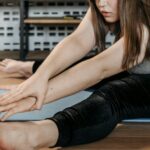The fitness world is constantly evolving, introducing new methods that promise to transform how we move, feel, and heal. Among these innovations, the Gyrotonic Method stands out as a unique approach that combines the flowing movements of dance with the precision of therapeutic exercise. But what exactly is Gyrotonic, and why are fitness enthusiasts, athletes, and rehabilitation specialists increasingly turning to this distinctive movement system?
What is the Gyrotonic Method?
The Gyrotonic Method is an original movement system that integrates circular and spiraling movements with coordinated breathing patterns. Unlike traditional linear exercises, Gyrotonic movements flow seamlessly from one position to the next, creating a continuous dance-like sequence that works the entire body as an integrated unit.
This innovative approach addresses the whole person by opening energy pathways, stimulating the nervous system, increasing range of motion, and improving both strength and movement efficiency. The method emphasizes natural movement patterns that allow joints to move through their full range of motion without jarring or compression, making it both therapeutic and strengthening.
Core Principles of Gyrotonic Movement
The Gyrotonic Method is built on several fundamental principles:
- Three-dimensional movement patterns that mirror how the body naturally moves in space
- Breath coordination that enhances the flow and effectiveness of each exercise
- Spinal articulation focusing on the spine’s natural curves and mobility
- Rhythmic repetition that creates a meditative, flowing quality
- Progressive resistance that adapts to individual strength and flexibility levels
The History and Origins of Gyrotonic
The Gyrotonic Method was created by Romanian-born dancer and gymnast Juliu Horvath in the 1980s. After suffering a career-ending Achilles tendon injury, Horvath found himself unable to continue his professional dance career. This setback became the catalyst for developing what would eventually become the Gyrotonic Method.
Initially calling his system “Yoga for Dancers,” Horvath drew from his extensive background in dance, yoga, gymnastics, swimming, and tai chi. He spent years refining the movements and developing specialized equipment that could support and enhance the three-dimensional movement patterns he envisioned.
Evolution of the Method
What began as a personal healing journey evolved into a comprehensive movement system that now serves people from all walks of life. Horvath’s vision was to create a method that could address the limitations he observed in traditional exercise approaches, particularly their tendency to work muscles in isolation rather than as integrated movement patterns.
Understanding Gyrotonic Equipment
One of the most distinctive aspects of the Gyrotonic Method is its specialized equipment, designed specifically to support the unique movement patterns of the system. The equipment is crafted from high-quality wood and features adjustable components that can accommodate practitioners of all sizes and abilities.
The Pulley Tower System
The primary piece of Gyrotonic equipment is the Pulley Tower, a sophisticated apparatus that uses weighted cables and pulleys to provide smooth, consistent resistance throughout the full range of motion. Key features include:
- Adjustable height settings to accommodate different body proportions
- Variable resistance through interchangeable weights
- Smooth pulley systems that eliminate jarring or sudden resistance changes
- Ergonomic design that supports natural body alignment
Additional Equipment
Beyond the Pulley Tower, the Gyrotonic system includes several other specialized pieces:
- Jumping Stretching Board: Focuses on leg and spinal movements
- Gyrotoner: Designed for more advanced practitioners
- Archway: Supports spinal extension and flexibility work
- Leg Extension Unit: Targets lower body strength and mobility
The Science Behind Gyrotonic Movements
The Gyrotonic Method is based on the understanding that the human body is designed for three-dimensional movement. Traditional exercise often focuses on linear, two-dimensional movements that don’t reflect how we naturally move in daily life.
Fascia and Nervous System Integration
Recent research in movement science has highlighted the importance of fascia – the connective tissue that surrounds and connects muscles throughout the body. Gyrotonic movements specifically target fascial lines, creating length and elasticity in these crucial support structures.
The method also emphasizes nervous system stimulation through:
- Proprioceptive challenges that improve body awareness
- Coordination patterns that enhance neural pathways
- Rhythmic breathing that activates the parasympathetic nervous system
Movement Biomechanics
Gyrotonic exercises work with the body’s natural movement patterns, including:
- Spiraling motions that reflect how muscles naturally contract and lengthen
- Multi-planar movements that engage stabilizing muscles
- Decompression techniques that create space in joints and the spine
Comprehensive Benefits of Gyrotonic
The unique approach of the Gyrotonic Method delivers a wide range of benefits that extend beyond traditional fitness outcomes.
Physical Benefits
Improved Spinal Mobility: The emphasis on spinal articulation helps maintain and restore the natural curves of the spine, reducing stiffness and improving overall back health.
Enhanced Flexibility and Strength: Unlike stretching alone, Gyrotonic builds strength through the full range of motion, creating functional flexibility that translates to daily activities.
Better Posture: The three-dimensional movements help rebalance muscle groups, addressing common postural imbalances caused by modern lifestyle habits.
Increased Coordination: The complex movement patterns challenge the nervous system, improving overall coordination and body awareness.
Mental and Emotional Benefits
Stress Reduction: The flowing, meditative quality of Gyrotonic movements activates the relaxation response, helping to reduce stress and anxiety.
Improved Focus: The concentration required for the coordinated movements enhances mental clarity and present-moment awareness.
Enhanced Body Confidence: As practitioners develop greater body awareness and movement efficiency, they often experience increased confidence in their physical abilities.
Gyrotonic in Rehabilitation and Therapy
The therapeutic applications of the Gyrotonic Method have gained significant recognition in the medical and rehabilitation communities. Physical therapists, chiropractors, and other healthcare professionals are increasingly incorporating Gyrotonic principles into their treatment protocols.
Clinical Applications
Spinal Conditions: The gentle, decompressive nature of Gyrotonic movements makes it particularly effective for addressing various spinal issues, including:
- Herniated discs
- Spinal stenosis
- Chronic back pain
- Post-surgical rehabilitation
Neurological Conditions: The method’s emphasis on nervous system stimulation has shown promise in working with conditions such as:
- Multiple sclerosis
- Parkinson’s disease
- Stroke recovery
- Balance disorders
Safety Considerations and Contraindications
While Gyrotonic is generally safe for most people, certain conditions require special consideration:
- Acute injuries: Should be fully healed before beginning Gyrotonic
- Severe osteoporosis: May require modifications to avoid spinal flexion
- Pregnancy: Requires instructor certification in prenatal modifications
- Recent surgeries: Medical clearance should be obtained before starting
How Gyrotonic Compares to Other Movement Methods
Understanding how Gyrotonic relates to other popular movement methods can help potential practitioners make informed decisions about their fitness journey.
Gyrotonic vs. Yoga
While both emphasize breath coordination and mind-body connection, key differences include:
- Equipment: Gyrotonic uses specialized apparatus for resistance and support
- Movement flow: Gyrotonic movements are more continuous and circular
- Resistance: Gyrotonic provides variable resistance throughout the range of motion
Gyrotonic vs. Pilates
Both methods focus on core strength and controlled movement, but they differ in:
- Movement patterns: Gyrotonic emphasizes three-dimensional, spiraling movements
- Equipment design: Gyrotonic equipment is specifically designed for circular movements
- Approach: Gyrotonic places greater emphasis on spinal mobility and nervous system stimulation
Gyrotonic vs. Traditional Strength Training
The contrast with conventional weight training is significant:
- Movement quality: Gyrotonic prioritizes movement efficiency over maximum load
- Joint health: Emphasis on decompression rather than compression
- Integration: Whole-body movement patterns versus isolated muscle work
What to Expect in Your First Gyrotonic Session
For newcomers to the Gyrotonic Method, understanding what to expect can help ease any apprehension and maximize the experience.
Initial Assessment
Your first session typically begins with a movement assessment where the instructor evaluates:
- Current range of motion
- Postural patterns
- Movement restrictions
- Individual goals and concerns
Session Structure
A typical Gyrotonic session includes:
- Warm-up movements to prepare the body
- Spinal preparation focusing on mobility and awareness
- Main exercise sequences tailored to individual needs
- Integration movements to consolidate the work
- Cool-down to promote relaxation and recovery
What to Wear and Bring
- Comfortable, form-fitting clothing that allows for full range of motion
- Grip socks or bare feet (no shoes on equipment)
- Water bottle for hydration
- Open mind and willingness to explore new movement patterns
Who Should Try Gyrotonic?
One of the most remarkable aspects of the Gyrotonic Method is its adaptability to virtually any population. The equipment’s adjustability and the method’s scalable nature make it accessible to a wide range of individuals.
Ideal Candidates
Fitness Enthusiasts: Those seeking a challenging yet gentle approach to maintaining and improving physical condition.
Athletes: Professional and amateur athletes looking to enhance performance, prevent injury, and improve movement efficiency.
Seniors: Older adults wanting to maintain mobility, balance, and independence while addressing age-related movement limitations.
Rehabilitation Patients: Individuals recovering from injury or managing chronic conditions who need a gentle yet effective approach to movement.
Desk Workers: People dealing with postural issues and movement restrictions from sedentary lifestyles.
Age and Ability Considerations
The Gyrotonic Method can be adapted for:
- Children and adolescents: Supporting healthy development and movement patterns
- Adults of all fitness levels: From beginners to elite athletes
- Seniors: Maintaining and improving mobility and balance
- Individuals with disabilities: Equipment modifications allow for inclusive participation
Training and Certification for Instructors
The quality and safety of Gyrotonic instruction depend heavily on proper training and certification. The Gyrotonic Method has established rigorous standards for instructor education.
Certification Requirements
Becoming a certified Gyrotonic instructor involves:
- Prerequisite training: Foundation courses in movement and anatomy
- Apprentice program: Hands-on learning under experienced instructors
- Continuing education: Ongoing training to maintain certification
- Specialization options: Additional certifications for specific populations or conditions
Finding Qualified Instructors
When seeking Gyrotonic instruction, look for:
- Current certification from Gyrotonic International
- Experience working with your specific needs or conditions
- Positive references from other clients
- Comfortable, well-equipped studio environment
The Future of Gyrotonic
As our understanding of movement science continues to evolve, the Gyrotonic Method remains at the forefront of innovative approaches to health and fitness. Current trends and developments include:
Research and Evidence
While anecdotal evidence for Gyrotonic’s benefits is abundant, the field is seeing increased interest in formal research studies to document its effectiveness for various conditions and populations.
Technology Integration
Some studios are beginning to incorporate technology to enhance the Gyrotonic experience, including:
- Movement analysis software
- Biofeedback systems
- Virtual reality applications for enhanced body awareness
Accessibility Initiatives
Efforts are underway to make Gyrotonic more accessible through:
- Scholarship programs for training
- Community outreach initiatives
- Adaptive equipment development
Frequently Asked Questions
Q: How often should I practice Gyrotonic?
A: Most practitioners benefit from 1-3 sessions per week, depending on their goals and current fitness level. Consistency is more important than frequency.
Q: Is Gyrotonic suitable for beginners?
A: Absolutely. The method is highly adaptable, and qualified instructors can modify exercises for any fitness level or physical limitation.
Q: How long does it take to see results?
A: Many people notice improvements in posture and movement quality within the first few sessions, while strength and flexibility gains typically become apparent within 4-6 weeks of regular practice.
Q: Can Gyrotonic help with chronic pain?
A: Many practitioners report significant improvements in chronic pain conditions, particularly those related to spinal issues. However, it’s important to work with both a qualified instructor and healthcare provider.
Q: What’s the difference between group and private sessions?
A: Due to equipment requirements, most Gyrotonic sessions are conducted privately or in very small groups (2-3 people). This allows for personalized attention and equipment adjustments.
Conclusion: Embracing a New Approach to Movement
The Gyrotonic Method represents a paradigm shift in how we think about exercise and movement. By honoring the body’s natural patterns and emphasizing integration over isolation, this innovative approach offers a path to improved health, enhanced performance, and greater movement freedom.
Whether you’re an athlete seeking to optimize performance, someone recovering from injury, or simply looking for a more holistic approach to fitness, the Gyrotonic Method offers unique benefits that extend far beyond traditional exercise. Its emphasis on three-dimensional movement, breath coordination, and nervous system integration creates an experience that is both challenging and nurturing.
As you consider incorporating Gyrotonic into your wellness routine, remember that the journey is as important as the destination. The method’s focus on mindful movement and body awareness can transform not just how you move, but how you relate to your body and navigate the world around you.
Ready to experience the transformative power of Gyrotonic? Find a certified instructor in your area and take the first step toward discovering what this revolutionary movement method can do for you. Your body – and mind – will thank you for the investment in this comprehensive approach to health and wellness.



